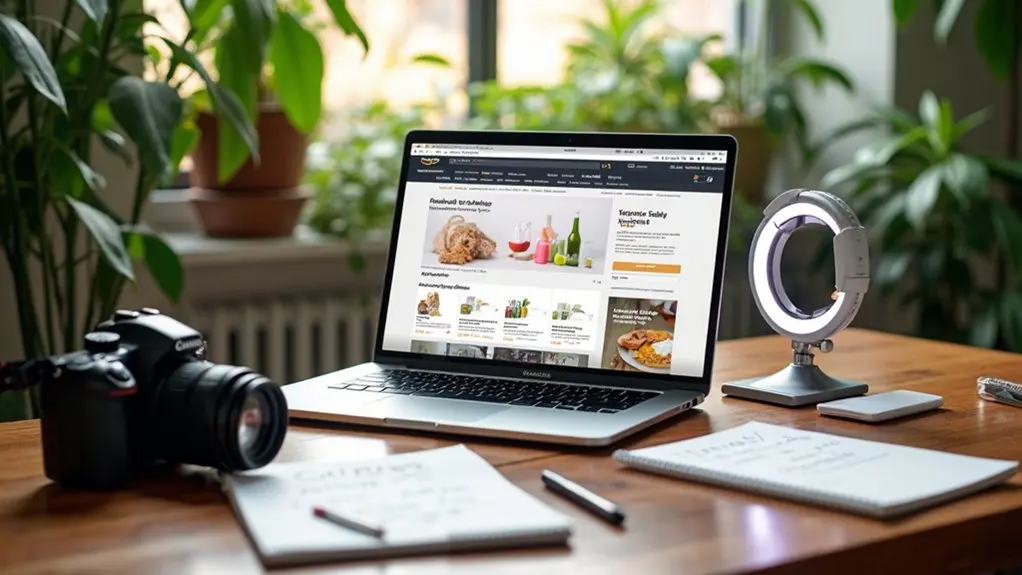To become an Amazon Influencer, one must build an engaged social media audience through high-quality, consistent content and regular interaction. The application process emphasizes audience engagement metrics over follower count, requiring public accounts and a compelling storefront concept. Successful influencers create branded storefronts, organize product collections, and use unique URLs for promotion. Strategic sharing on multiple platforms maximizes commissions. Discover the best practices for storefront setup, audience growth strategies, and ideal promotion techniques just ahead.
Key Takeaways
- Grow your audience by consistently posting high-quality, engaging content on public social media accounts.
- Focus on interaction and engagement rates, as Amazon prioritizes these metrics over follower count for program acceptance.
- Prepare your application with a compelling storefront name, tagline, and ensure you follow affiliate disclosure requirements.
- Customize your Amazon storefront with branded images and organized product collections to attract and retain visitors.
- Promote your storefront link across all social media platforms using targeted, platform-specific strategies to maximize visibility and earnings.
Understanding the Amazon Influencer Program
The Amazon Influencer Program leverages the power of social media by enabling individuals with engaged online audiences to monetize their influence through curated storefronts on Amazon.
Applicants are evaluated not only on follower counts but on engagement metrics—likes, comments, and shares—reflecting the program’s data-driven approach to influencer marketing.
Successful applicants can create personalized storefronts to promote products, earning commissions between 1% and 10% depending on product categories. High-performing sectors include luxury beauty, while grocery and gaming yield lower rates.
Influencers can earn commissions from 1% to 10% on curated storefronts, with luxury beauty paying more than grocery or gaming products.
Influencers are issued a unique URL, which can be strategically integrated across social channels to drive conversions.
To remain eligible, influencers must maintain a strong social media presence, post high-quality content regularly, and comply with Amazon’s periodic content reviews when applying for the Amazon Influencer Program.
Growing and Engaging Your Social Media Audience
Consistent, high-quality content remains the foundation of successful audience growth and engagement across social media platforms, as evidenced by current trends and algorithmic preferences.
For aspiring Amazon influencers, growing audience engagement requires a strategic focus on both the type and delivery of content. Consistency is key; maintaining a regular posting schedule boosts visibility and reinforces loyalty.
Capitalizing on platform-specific features, such as Instagram Stories or TikTok challenges, further amplifies reach and interactivity. To optimize results, creators must analyze engagement metrics to refine their content strategy according to evolving audience preferences.
Direct interaction also plays a critical role, fostering connection and trust.
- Develop a consistent, high-quality content calendar.
- Utilize platform-specific features to boost engagement.
- Interact with your audience to build a community and refine your content.
Meeting the Requirements and Preparing Your Application
Achieving Amazon Influencer status hinges on meeting well-defined eligibility standards and executing a meticulous application process.
Prospective creators must possess a public social media account—Instagram, Facebook (business account), YouTube, or TikTok—where audience engagement rates and engagement metrics like likes, comments, and shares are prioritized over follower count.
Consistently producing high-quality content and demonstrating robust influencer marketing activity is essential, as Amazon sporadically reviews accounts post-approval.
To apply for the Amazon Influencer Program, candidates visit the program homepage, sign up, and link their chosen social media accounts.
The application requires a compelling storefront name and tagline, aligning with branding best practices.
Including an affiliate disclosure (such as #Ad or #Sponsored) in content is necessary for compliance and transparency throughout the Amazon Influencer account application process.
Creating and Customizing Your Amazon Influencer Storefront
How can influencers maximize their impact on Amazon? By creating and customizing an Amazon Influencer storefront, they leverage data-driven design to boost audience engagement and conversions.
Influencers can upload a compelling header image and profile picture to anchor their brand identity, making their storefront visually appealing and memorable. Organizing product listings into theme collections or categories streamlines navigation, enhancing the customer experience and driving more targeted purchases.
Utilizing the unique vanity URL strengthens brand recognition and enables seamless sharing across social media channels.
Key steps for creating custom storefronts include:
- Uploading a distinctive header image and profile picture for brand consistency
- Curating product listings into theme collections for better discoverability
- Regularly updating content to maintain audience engagement and encourage repeat visits
This structured approach amplifies influencer success on Amazon.
Promoting Your Storefront and Maximizing Earnings
After building a tailored and visually striking Amazon Influencer storefront, the next step is driving targeted traffic and optimizing revenue streams.
Promoting your Amazon Influencer storefront begins by placing the storefront link across high-traffic social media platforms—Instagram bios, Facebook posts, and YouTube descriptions—ensuring seamless audience access.
Consistently publishing high-quality content increases visibility and encourages click-throughs, directly impacting commission rates.
Regularly sharing standout content boosts your storefront’s visibility and drives more clicks, leading to higher commissions.
Utilizing platform-specific content strategies, such as Instagram Stories for product spotlights or employing TikTok trends for creative demonstrations, aligns with current audience preferences and maximizes engagement.
Data-driven influencers closely monitor engagement metrics, adapting promotional tactics to what drives conversions.
Frequently Asked Questions
How to Get Accepted for the Amazon Influencer Program?
Acceptance into the Amazon Influencer Program relies on application tips emphasizing influencer strategies, content creation, niche selection, and branding techniques. Strong audience engagement, social media growth, video marketing, trust building, and relevant product recommendations greatly boost approval odds, reflecting current digital trends.
Is It Hard to Get Into the Amazon Influencer Program?
Amazon Influencer challenges include meeting platform social media engagement benchmarks and utilizing content creation strategies. Audience building tips, niche selection advice, and authenticity in promotion are essential for approval, while influencer marketing trends highlight monetization techniques and brand collaboration opportunities for sustained growth.
How to Get Accepted Into the Amazon Affiliate Program?
Acceptance into the Amazon affiliate program requires following Amazon affiliate tips, utilizing best practices like niche selection and content strategies, maximizing audience engagement on social media, creating product reviews, employing marketing techniques, monitoring commission rates, and learning from success stories.
Why Did I Not Qualify for the Amazon Influencer Program?
Failure to qualify for the Amazon Influencer Program often results from not meeting qualification criteria in the application process, such as insufficient content quality, low audience engagement, weak social media presence, niche selection misalignment, inadequate follower count, or non-compliance with platform guidelines.
Conclusion
Becoming an Amazon Influencer is a strategic move for content creators seeking new revenue streams. With over 300 million active Amazon users and influencer marketing set to surpass $21 billion globally, the opportunity is significant. Success hinges on cultivating an engaged audience, meeting Amazon’s eligibility criteria, and optimizing a tailored storefront. Through utilizing data-driven promotion and monitoring conversion trends, influencers can maximize earnings and solidify their presence in the rapidly expanding affiliate marketing environment.




